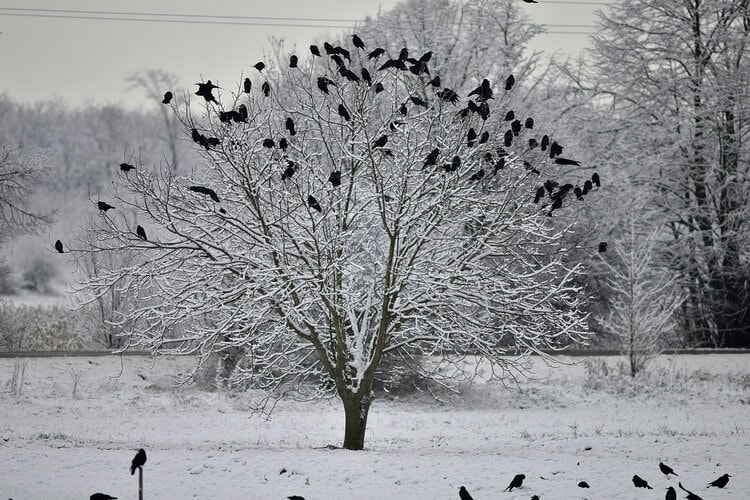Do Crows Migrate? Where Do They Go in Winter?
Last Updated on

You can find crows almost anywhere in the United States but there only seems to be a few of them during the cold winter months leaving many people to question if crows migrate. The short answer is sometimes, so keep reading while we try to explain what that means so you can better understand the animals in your environment.

Do Crows Migrate?
Yes. Many crows migrate from one place to another, but it’s different from how other birds migrate. Crows are partially migratory, which means that some of them migrate while others do not. Scientists aren’t sure why this happened, but they believe it helps the species deal with little food during the colder months. As some of the birds move away, it leaves more for those that remain.
Why Do Crows Migrate?
Cold Weather
Like many bird species, some crows seem to fly south as the weather gets cold. More crows seem to migrate in states where the weather frequently gets below zero degrees Fahrenheit.
Mating
For many crows that migrate, it seems closely tied to the mating season. The crows migrate to their new places and breed. They will usually wait for the eggs to hatch and return to their original location 28 to 35 days later. Many baby crows leave the nest before flying and must spend several days on the ground before joining their flock.
Do The Same Crows Migrate Every Year?

Yes. There are two types of birds in the flock or murder as it’s officially called: birds that migrate and those that don’t. Birds that migrate will do so every year, and those that don’t will stay home. They never switched roles, and the pattern will continue until they die.
When Do Crows Migrate?
Crows usually start to migrate in early January and return home sometime in March after the coldest winter months are over and food is beginning to grow again. They will usually migrate to the same spot each year for breeding but might spend spring in a different location.
How Far Do Crows Migrate?
Crows will usually migrate 300 miles or more depending on how cold it is in their state, with some reaching 500 or even 600 miles from their original location, though these extreme numbers are a little less common. Scientists were able to track the migration activity, including the distance many crows travel using satellite technology. Since the crows travel to the same location each year, we can use the information to see how changes affect their patterns, so it can help scientists understand the impacts of climate change and environmental change.

Conclusion
Crows are an interesting bird species that are partially migratory. While scientists aren’t sure why the birds migrate, they believe it’s because of less food in colder areas. The birds that leave make it easier for the birds that remain to find food. The breeding is also closely tied to mating, and the crows that migrate return to the same breeding spot each year to have more offspring before returning home.
We hope you have enjoyed reading over this short guide and found the answers to your questions. If we have helped you understand these intelligent birds better, please share our look into if crows migrate on Facebook and Twitter.
Featured Image Credit: almassy, Shutterstock
About the Author Ed Malaker
Ed Malaker is a veteran writer who contributes to a wide range of blogs covering information on computer programming, pets, birding, tools, fitness, guitars, and optics. Outside of writing, Ed is often found working in the garden or performing DIY projects in the house. Ed is also a musician, spending his time composing music for independent films or helping people repair their guitars.
Related Articles:
How to Clean a Refractor Telescope: Step-by-Step Guide
How to Clean a Telescope Eyepiece: Step-by-Step Guide
How to Clean a Rifle Scope: 8 Expert Tips
Monocular vs Telescope: Differences Explained (With Pictures)
What Is a Monocular Used For? 8 Common Functions
How to Clean a Telescope Mirror: 8 Expert Tips
Brightfield vs Phase Contrast Microscopy: The Differences Explained
SkyCamHD Drone Review: Pros, Cons, FAQ, & Verdict
